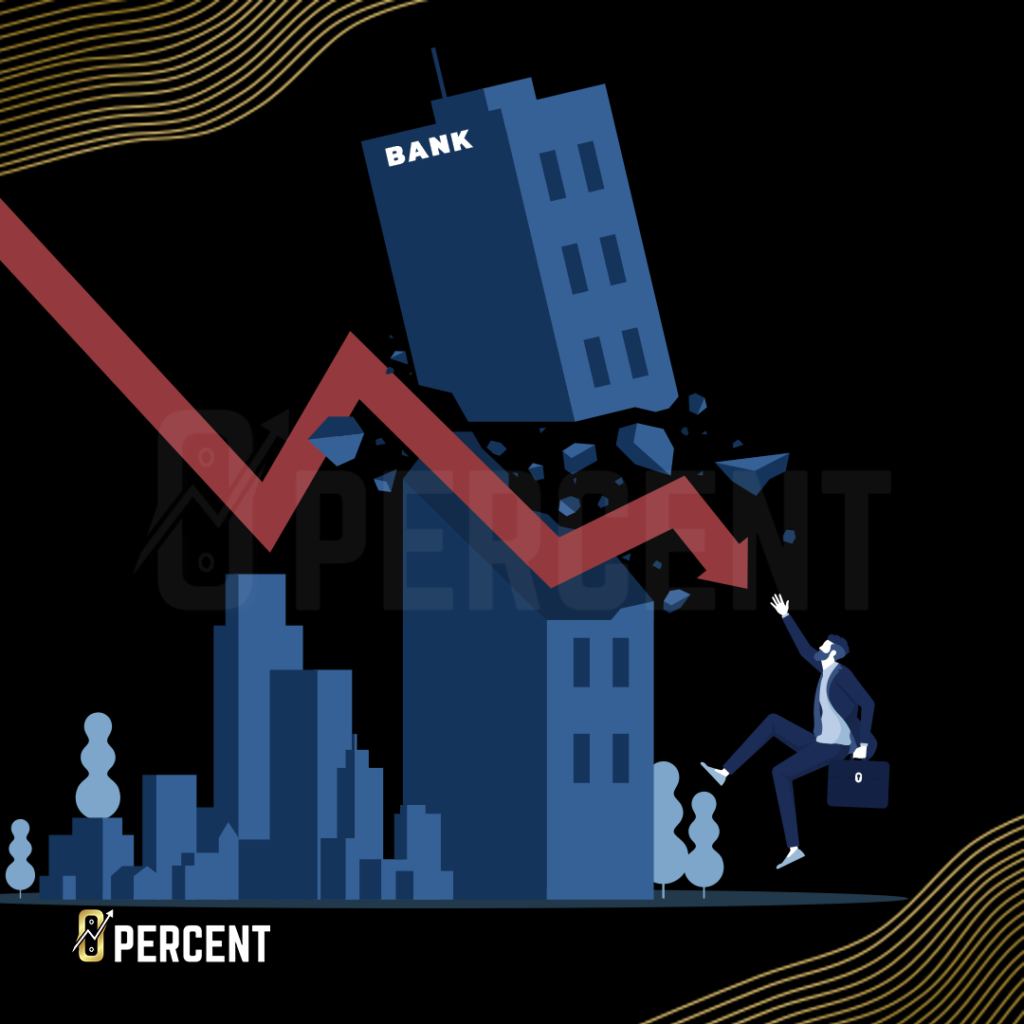
Jeff Sekinger
Jeff Sekinger Founder & CEO, 0 Percent Who is Jeff Sekinger? Visionary Trailblazer Sekinger has been in the financial industry for over a decade. Starting
During times of economic and financial crisis, governments will often consider the idea of bank bailouts as a solution to stabilizing the financial system and mitigating negative externalities. A bank bailout is exactly what it sounds like: providing financial support to a struggling bank or financial institution, whether large or small, to help prevent it from total collapse. Bank bailouts can come in the form of loans, capital injections, or guarantees that protect depositors.
For obvious reasons, bank bailouts have always been a controversial subject, with far reaching economic and political implications. On one side, critics argue that bank bailouts reward bad behavior and poor decision making, encouraging more risky behaviors by the banks. Supporters of bank bailouts, on the other hand, argue that bailouts are necessary to prevent or mitigate a much larger financial crisis. In either case — whether banks are bailed out or not — the implications and consequences are wide, and affect individuals, nations and the geopolitics of the world.

The History of Bank Bailouts
Bank bailouts are hardly a novel concept, but rather have been implemented for centuries. Even in the earliest days of banking, bailouts have been used in times of crisis. In the 19th and 20th centuries, bank failures were more common than they are today, due to a lack of regulation, standardization and supervision. Even in the United States, banks from one state could issue currency that was not recognized in another. This was because for a period of time, the US did not have a unified currency until the mid 19th century. In response, governments around the world started providing support to struggling banks to prevent a run on the banks and protect depositors.
During the Great Depression in the United States, the federal government created the Reconstruction Finance Corporation (RFC) to provide loans to struggling banks and businesses. The RFC was able to help prevent a total collapse of the banking system, and helped to stabilize the overall economy.
More recently, the global financial crisis of 2008 prompted a series of bank bailouts by governments around the world. With the collapse of Lehman Brothers and other major banks and financial institutions, and with the freezing of credit markets, a panic ensued. Governments responded with very large bailouts to prevent further collapse.
Throughout history, there have been many significant bailouts throughout the world. Here are the 5 biggest bailouts in history:
These 5 bailouts were the largest in world history. These bailouts demonstrate the significance that bank failures can have on the overall economy. In many cases, the cost of these bailouts was burdened on the shoulders of taxpayers.
Of those 5, the bailout following the financial crisis of 2008 in the United States was the most significant, at roughly $700 billion. The exact amount that the American taxpayers had to pay is difficult to calculate, as various factors come into play beyond the specific dollar amount. This includes the ultimate cost of various bailout programs, as well as the overall economic impact of the crisis. However, it is estimated that the direct financial burden of the bailout to taxpayers was approximately $426 billion, while the overall cost of the crisis to the U.S. economy, including lost output and reduced tax revenue, was much higher. Astonishingly, this figure is estimated to be in the trillions of dollars.
Looking domestically, the biggest bank bailouts in U.S. history are:
Of the 5 largest bailouts in US history, 4 occurred in the wake of the 2008 financial crisis. This gives a glimpse into the significance of that period and the far reaching consequences that are still being felt to this day.
Types of Bank Bailouts
Bank bailouts can come in various forms. For example, in 2008 the government bailed out the banks via capital injections in exchange for preferred stock or other securities, and also included other forms of support, such as the Federal Reserve’s emergency lending facilities, which provided short term funding to banks financial institutions
The most common types of bank bailouts that governments use include:
The Pros and Cons of Bank Bailouts
There are several arguments both for and against bailouts. Supporters argue that bailouts are necessary in order to prevent a total collapse of the financial system. A complete collapse would of course have catastrophic consequences for the economy and society. Supporters also argue that bailouts can help prevent the loss of jobs and protect the savings of depositors.
Critics of bailouts argue that they reward poor decision making by banks, and encourage risk taking. They also argue the moral hazards point of view, where banks feel that they can take risks without fear of failure because they believe the government will always bail them out. Moreover, critics argue that because the burden typically falls on taxpayers’ shoulders, the ethics behind bank bailouts are not adequate.
Here are 5 of the main sources of funds that are typically used to bail out failed banks:
It is important to note that the specific sources of funds used to bail out a failed bank can vary depending on the country and the circumstances surrounding the failure. Moreover, these are not the only ways banks can be bailed out — only the most often used methods.
Signs That Precede a Bank’s Collapse
It is essential to be aware of the signs that a bank may be in trouble so that you can take necessary precautions to protect your financial assets. Here are some warning signs that may indicate a bank’s impending collapse.
While these signs are not definitive, they can serve as potential red flags indicating that a bank may be in trouble.
Why Not Just Let the Banks Fail?
If banks are not bailed out and allowed to collapse, it can have significant consequences for the economy and the financial system. Some of the possible consequences are:
1. Loss of confidence: When a bank collapses, it can erode public confidence in the financial system. This loss of confidence can lead to a run on other banks, as depositors rush to withdraw their funds, which can exacerbate the crisis.
2. Bank Runs: When one bank collapses, especially if it is a major institution, this can create panic and a run on the banks. A bank run is when large numbers of people rush to withdraw their deposits. Due to the fractional reserve nature of the currency banking system, banks are usually not able to supply everyone’s simultaneous withdrawals. Bank runs can exacerbate or accelerate a financial crisis.
3. Economic recession: The collapse of a bank can have a ripple effect on the economy, as it can lead to a credit crunch and a contraction in lending. This, in turn, can lead to a slowdown in economic activity and potentially a recession.
4. Job losses: Bank failures can result in significant job losses, as employees of the failed bank and other businesses that relied on the bank may be affected.
5. Loss of savings: When a bank fails, depositors may lose their savings if the deposits exceed the limit covered by deposit insurance. This can have a significant impact on individuals and businesses who may not be able to recover their savings.
6. Systemic risk: The failure of a bank can also have systemic implications, as it can lead to a contagion effect that spreads to other banks and financial institutions, potentially causing a wider financial crisis.
Bank collapses are no small deal, and can have long lasting consequences that impact both individuals and the economy. Bank collapses can also have far reaching global geopolitical consequences. This is why it is important for governments to intervene, in one form or another, to prevent failures and minimize the potential impact of those failures.
Prevention Is Better Than the Cure
Dealing with bank failures after said failure is important, but implementing measures that can help prevent failures from happening in the first place is even more crucial to the health and security of the financial sphere. There are several steps that governments can take to help prevent future bank collapses:
1. Strengthen regulatory oversight: Governments can increase the power and resources of their regulatory agencies to better monitor banks and financial institutions. This can include implementing stricter capital requirements, stress testing, and other measures to ensure that banks have sufficient liquidity and are not taking excessive risks.
2. Improve transparency and accountability: Governments can require banks to be more transparent in their financial reporting and disclose more information about their activities. This can help investors and regulators better understand the risks associated with different financial products and institutions.
3. Increase consumer protection: Governments can implement stronger consumer protection regulations to ensure that individuals and businesses are not taken advantage of by financial institutions. This can include measures such as prohibiting predatory lending practices, regulating fees and charges, and ensuring that consumers have access to financial education and resources.
4. Foster competition: Governments can promote competition in the financial industry by encouraging the entry of new players and limiting the power of established institutions. This can help prevent the formation of large, too-big-to-fail banks that can pose a systemic risk to the financial system.
5. Develop crisis management plans: Governments can create contingency plans to manage financial crises, including the possibility of bank failures. This can involve establishing mechanisms for orderly resolution of failed banks and ensuring that there are adequate resources available to stabilize the financial system in the event of a crisis.
By implementing these critical measures, governments can potentially prevent future bank collapses and help to minimize the impact of financial crises on the economy and society as a whole. As the saying goes: an ounce of prevention is better than a pound of cure.
Bank bailouts are indeed a controversial subject, with supporters and critics arguing all sides. In either case, bank failures can have severe consequences, depending on the size of the bank. Bailouts have been used for centuries, and are likely to continue to be used in the future — unless strict and effective measures are put into place to completely prevent bank failures from happening.

Jeff Sekinger Founder & CEO, 0 Percent Who is Jeff Sekinger? Visionary Trailblazer Sekinger has been in the financial industry for over a decade. Starting

Angel Alvarez Funding, 0 Percent Who is Angel Alvarez? From SpaceX to 0 Percent Angel is a remarkably well rounded individual who has had a

Abhay AnandProduct, 0 Percent Who is Abhay Anand? Title One Test Title Two Test Test
Sign up for our newsletter to stay in the loop.
Sign up to receive news & updates!
Sign up to receive news & updates!